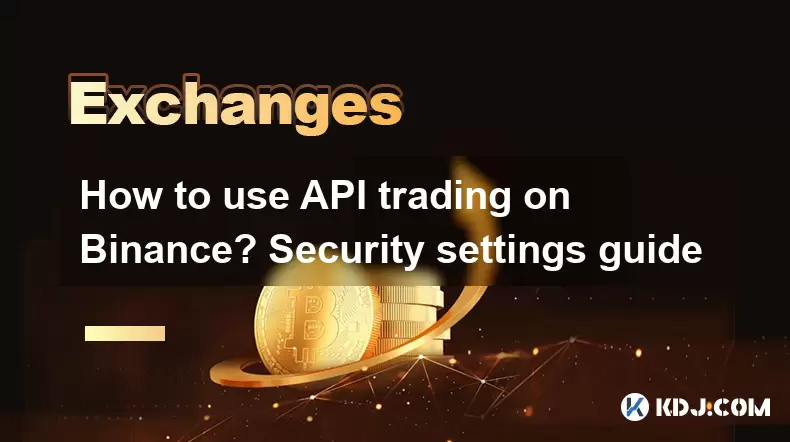-
 bitcoin
bitcoin $87959.907984 USD
1.34% -
 ethereum
ethereum $2920.497338 USD
3.04% -
 tether
tether $0.999775 USD
0.00% -
 xrp
xrp $2.237324 USD
8.12% -
 bnb
bnb $860.243768 USD
0.90% -
 solana
solana $138.089498 USD
5.43% -
 usd-coin
usd-coin $0.999807 USD
0.01% -
 tron
tron $0.272801 USD
-1.53% -
 dogecoin
dogecoin $0.150904 USD
2.96% -
 cardano
cardano $0.421635 USD
1.97% -
 hyperliquid
hyperliquid $32.152445 USD
2.23% -
 bitcoin-cash
bitcoin-cash $533.301069 USD
-1.94% -
 chainlink
chainlink $12.953417 USD
2.68% -
 unus-sed-leo
unus-sed-leo $9.535951 USD
0.73% -
 zcash
zcash $521.483386 USD
-2.87%
How to use API trading on Binance? Security settings guide
Using the Binance API enhances trading with automation and data access, but securing your API keys is crucial to prevent unauthorized account access.
May 08, 2025 at 09:56 pm

Trading on Binance using their API can significantly enhance your trading capabilities, allowing for automated trading, data retrieval, and more. However, ensuring the security of your API keys is crucial to protect your account from unauthorized access. This guide will walk you through the steps of setting up and using API trading on Binance, along with detailed instructions on managing your security settings.
Setting Up Your Binance API
To begin using the Binance API for trading, you need to create an API key. Here's how you can do it:
- Log in to your Binance account.
- Navigate to the Profile icon at the top right corner of the page, and click on API Management.
- Click on Create New Key. You will be prompted to enter your two-factor authentication (2FA) code if it is enabled.
- After entering your 2FA code, you will be provided with an API key and a Secret key. The Secret key will only be shown once, so make sure to save it securely.
- You can set permissions for your API key, such as enabling or disabling trading, withdrawals, and other functions. Adjust these permissions according to your needs.
Using the Binance API for Trading
Once you have your API keys set up, you can start using them to interact with the Binance platform programmatically. Here's a basic example of how to place an order using the Binance API:
- Choose a programming language and a library that supports the Binance API, such as Python with the
python-binancelibrary. - Install the library using a package manager. For Python, you can use pip:
pip install python-binance. - Import the library in your script and initialize the client with your API key and Secret key:
from binance.client import Client
client = Client(api_key='your_api_key', api_secret='your_secret_key')
- Place an order using the
order_market_buyororder_market_sellfunctions. Here's an example of a market buy order:
order = client.order_market_buy(
symbol='BTCUSDT',
quantity=0.001
)print(order)
Security Settings for Your Binance API
Securing your API keys is paramount. Here are detailed steps to enhance the security of your API trading on Binance:
Restrict IP Access: In the API Management section, you can restrict your API key to only work from specific IP addresses. This adds an extra layer of security by ensuring that only requests from those IPs can use your API key.
Set Expiration Dates: You can set an expiration date for your API key. This is useful if you only need the key for a limited time, as it will automatically become invalid after the set date.
Enable Two-Factor Authentication (2FA): Always have 2FA enabled on your Binance account. This adds an additional layer of security, making it harder for unauthorized users to access your account even if they obtain your API keys.
Use Read-Only Keys for Non-Trading Purposes: If you are using the API for data retrieval rather than trading, create a read-only API key. This limits the potential damage if the key is compromised.
Regularly Rotate Your Keys: Change your API keys periodically to minimize the risk of long-term exposure. If you suspect any unauthorized access, immediately revoke and regenerate your keys.
Managing Your API Keys
Managing your API keys effectively is essential for maintaining the security of your account. Here are some best practices:
Keep Your Secret Key Secure: Never share your Secret key with anyone or store it in plain text. Use secure methods like environment variables or encrypted storage.
Monitor API Activity: Regularly check the API Management section on Binance to monitor the activity of your keys. Look for any unusual activity and take action if necessary.
Revoke and Regenerate Keys: If you suspect any compromise, immediately revoke your current keys and generate new ones. To do this, go to the API Management section, select the key you want to revoke, and click on Delete. Then, create a new key following the steps mentioned earlier.
Using API Trading Tools
There are various tools and platforms available that can help you leverage the Binance API for trading. Here are a few examples:
Trading Bots: Automated trading bots like 3Commas or Cryptohopper can be configured to use your Binance API keys for executing trades based on predefined strategies.
Trading Terminals: Platforms like TradingView allow you to connect your Binance account via API to execute trades directly from their interface.
Custom Scripts: If you have programming skills, you can write custom scripts to automate your trading strategies using the Binance API.
Frequently Asked Questions
Q: Can I use the same API key for multiple trading bots?A: Yes, you can use the same API key for multiple trading bots, but it is not recommended for security reasons. Each bot should have its own set of keys to minimize the risk of unauthorized access if one bot is compromised.
Q: How often should I rotate my API keys?A: It is a good practice to rotate your API keys at least every few months, or immediately if you suspect any security breach. Regular rotation helps in maintaining the security of your account.
Q: What should I do if I lose my Secret key?A: If you lose your Secret key, you should immediately revoke the associated API key from the API Management section on Binance and generate a new key. Always keep a secure backup of your Secret key to avoid such situations.
Q: Can I use the Binance API to trade on the futures market?A: Yes, the Binance API supports trading on both the spot and futures markets. You will need to ensure that your API key has the necessary permissions to access the futures market.
Disclaimer:info@kdj.com
The information provided is not trading advice. kdj.com does not assume any responsibility for any investments made based on the information provided in this article. Cryptocurrencies are highly volatile and it is highly recommended that you invest with caution after thorough research!
If you believe that the content used on this website infringes your copyright, please contact us immediately (info@kdj.com) and we will delete it promptly.
- Sisvida Exchange Achieves New Heights in Platform Stability, High-Load Performance, and Core Optimization
- 2025-12-23 03:35:01
- The Great Rebalance: Precious Metals Rally to Reshape Market Amid Crypto's Wane
- 2025-12-23 04:20:02
- Bitcoin Munari Gears Up for Token Launch: Presale Window Dynamics Unveiled
- 2025-12-23 04:20:02
- Fiserv, Visa, and Mastercard Forge Ahead: Securing the Future of AI-Powered Payments
- 2025-12-23 04:10:02
- Coinbase, Prediction Markets, and the Shifting Sands of Financial Clearing: A 2026 Tax Tweak Reshapes the Game
- 2025-12-23 04:10:02
- Coinbase Bets Big on Tomorrow: Acquires The Clearing Company to Turbocharge Prediction Markets
- 2025-12-23 04:25:01
Related knowledge

What does it mean to "Hedge" a position on Bybit and how do I do it?
Dec 11,2025 at 07:00pm
Understanding Position Hedging on Bybit1. Hedging on Bybit refers to opening opposing positions in the same trading pair to reduce exposure to adverse...

How to secure my Bybit account against phishing and scams?
Dec 12,2025 at 11:39am
Enable Two-Factor Authentication (2FA)1. Log in to your Bybit account and navigate to the Security Settings section. 2. Select Google Authenticator or...

Why is the price mark on Bybit different from the last traded price?
Dec 17,2025 at 07:19am
Price Mark Mechanism on Bybit1. Bybit uses a mark price rather than the last traded price to calculate unrealized P&L and determine liquidation events...

How does Bybit's VIP program work and what are the benefits?
Dec 18,2025 at 05:00pm
Structure of Bybit VIP Program1. The Bybit VIP program categorizes users into tiers based on their 30-day average net asset value and trading volume a...

What is the "Reduce-Only" option on Bybit and how does it prevent accidental orders?
Dec 15,2025 at 10:40am
Understanding Reduce-Only Mode1. Reduce-Only is a risk control feature on Bybit that restricts order execution to positions that only decrease or clos...

How to convert small balances ("dust") to another coin on Bybit?
Dec 07,2025 at 08:59pm
Understanding Dust Conversion on Bybit1. Dust refers to tiny, non-withdrawable balances of cryptocurrencies left in a user’s spot wallet after partial...

What does it mean to "Hedge" a position on Bybit and how do I do it?
Dec 11,2025 at 07:00pm
Understanding Position Hedging on Bybit1. Hedging on Bybit refers to opening opposing positions in the same trading pair to reduce exposure to adverse...

How to secure my Bybit account against phishing and scams?
Dec 12,2025 at 11:39am
Enable Two-Factor Authentication (2FA)1. Log in to your Bybit account and navigate to the Security Settings section. 2. Select Google Authenticator or...

Why is the price mark on Bybit different from the last traded price?
Dec 17,2025 at 07:19am
Price Mark Mechanism on Bybit1. Bybit uses a mark price rather than the last traded price to calculate unrealized P&L and determine liquidation events...

How does Bybit's VIP program work and what are the benefits?
Dec 18,2025 at 05:00pm
Structure of Bybit VIP Program1. The Bybit VIP program categorizes users into tiers based on their 30-day average net asset value and trading volume a...

What is the "Reduce-Only" option on Bybit and how does it prevent accidental orders?
Dec 15,2025 at 10:40am
Understanding Reduce-Only Mode1. Reduce-Only is a risk control feature on Bybit that restricts order execution to positions that only decrease or clos...

How to convert small balances ("dust") to another coin on Bybit?
Dec 07,2025 at 08:59pm
Understanding Dust Conversion on Bybit1. Dust refers to tiny, non-withdrawable balances of cryptocurrencies left in a user’s spot wallet after partial...
See all articles









































































